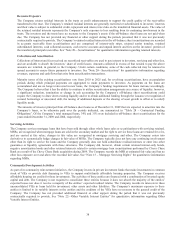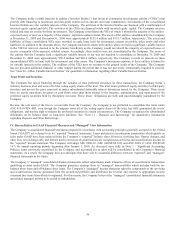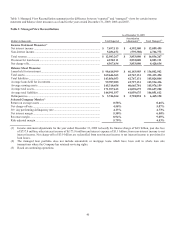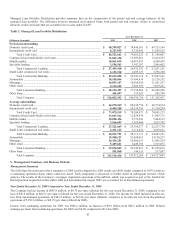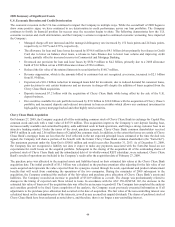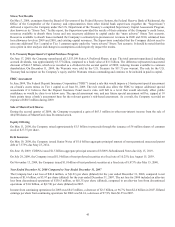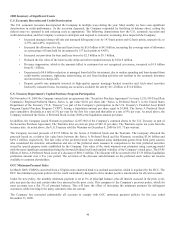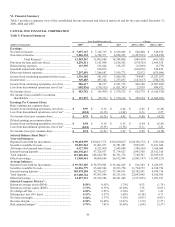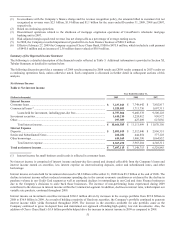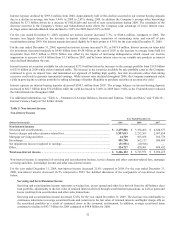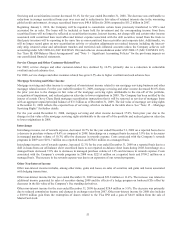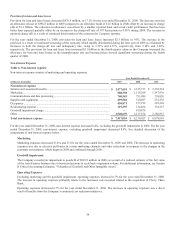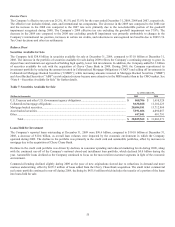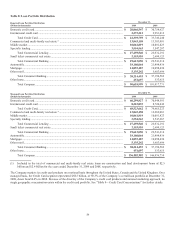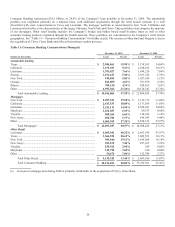Capital One 2009 Annual Report Download - page 61
Download and view the complete annual report
Please find page 61 of the 2009 Capital One annual report below. You can navigate through the pages in the report by either clicking on the pages listed below, or by using the keyword search tool below to find specific information within the annual report. 48
Gain on Sale of MasterCard Shares
As a result of MasterCard’s IPO in 2006, Capital One owned class B shares of MasterCard common stock, with sale restrictions that
were originally scheduled to expire on May 31, 2010. In 2007 shareholders approved an amendment to the MasterCard Certificate of
Incorporation that provides for an accelerated conversion of class B common stock into class A common stock. The MasterCard Board
of Directors approved a conversion window running from August 4 to October 5, 2007, during which time owners of class B shares
may voluntarily elect to convert and sell a certain number of their shares. During the conversion period, Capital One elected to convert
and sell 300,482 shares of MasterCard class B common stock. The Company recognized gains of $43.4 million on these transactions
in non-interest income.
Gain on Sale of Equity Interest in DealerTrack
In 2001 we acquired a 7% stake in the privately held company DealerTrack, a leading provider of on-demand software and data
solutions for the automotive retail industry. DealerTrack went public in 2005. During the first quarter of 2007 we sold our remaining
interest of 1,832,767 shares for $52.2 million resulting in a pre-tax gain of $46.2 million in non-interest income.
Senior Note Issuance
During the third quarter 2007, we closed the public offering of $1.5 billion aggregate principal amount of our Senior Notes Due 2017
(the “Notes”). The Notes were issued pursuant to a Senior Indenture dated as of November 1, 1996 (the “Indenture”) between the
Corporation and The Bank of New York Trust Company, N.A. (as successor to Harris Trust and Savings Bank), as Indenture Trustee.
Proceeds from the sale of the notes will be used for general corporate purposes, which may include repurchases of shares of our
common stock.
Acceleration of Equity Awards
During the second quarter of 2007, a charge of $39.8 million was taken against salaries and associate benefits. This charge was taken
as a result of the accelerated vesting of equity awards in conjunction with the transition of the Banking leadership team, consistent
with the terms of the awards. This charge is not included as a restructuring charge associated with our 2007 cost initiative.
Income Taxes
We recognized a $69.0 million one-time tax benefit in the second quarter of 2007 resulting from previously unrecognized tax benefits
related to our international tax position. In addition, we recognized a $29.7 million reduction in retained earnings associated with the
adoption of ASU 740-10/FIN 48 in 2007.
Business Outlook
The statements contained in this section are based on our current expectations regarding the Company’s 2010 financial results and
business strategies. Certain statements are forward looking statements within the meaning of the Private Securities Litigation Reform
Act of 1995. Actual results could differ materially from those in our forward looking statements. Factors that could materially
influence results are set forth throughout this section and in Item 1A “Risk Factors”.
The Company expects continuing cyclical economic challenges in 2010, although the pace of economic deterioration has slowed
during the second half of 2009. The Company expects that the U.S. Unemployment Rate will remain above 10% throughout 2010, and
that the Case-Schiller 20-City Index of home prices will fall 11% from its year end 2009 level.
The Company expects that credit trends will continue to be a key driver of its near-term results. While charge-offs in the Company’s
consumer lending businesses other than the mortgage portfolio are nearing a cyclical peak, the Company does not expect a rapid
recovery. Rather, the Company expects charge-offs in the consumer lending businesses other than the mortgage portfolio to remain
stubbornly high in 2010 as they begin a gradual recovery. The Company expects that charge-offs in the mortgage portfolio and the
Commercial Banking business will continue to deteriorate in 2010.
In addition to credit trends, the Company expects that its near-term results will reflect the mechanics of delivering value through the
cycle. The Company expects that loans will continue to decline into 2010, driven largely by continuing runoff of businesses the
Company exited or repositioned earlier in the recession. As the Company’s consumer businesses other than the mortgage portfolio
near the peak of charge-off dollars, the Company expects that the combination of declining loan balances and moderating credit
outlook creates the potential for significant allowance releases. The Company expects that potential allowance releases could coincide
with expected investments in marketing and infrastructure. The Company expects that any future loan growth and returns that may
result from the marketing and infrastructure investments would lag the investments, as they have in the past. The Company believes
that potential returns generated by marketing and other investments would be attractive and sustainable over the long-term.


